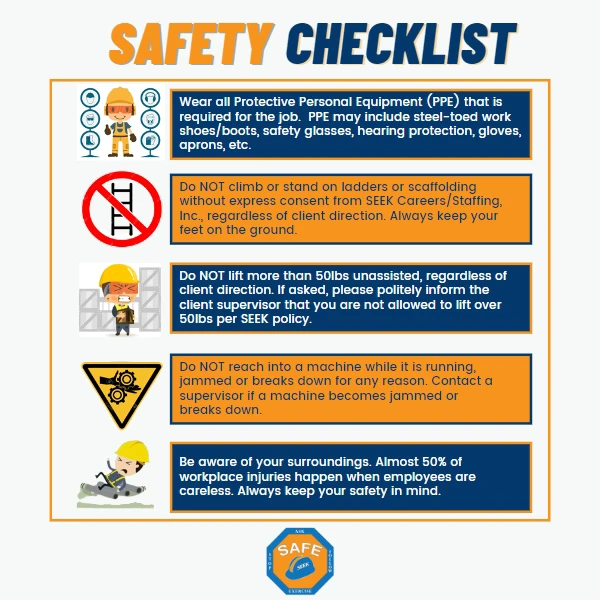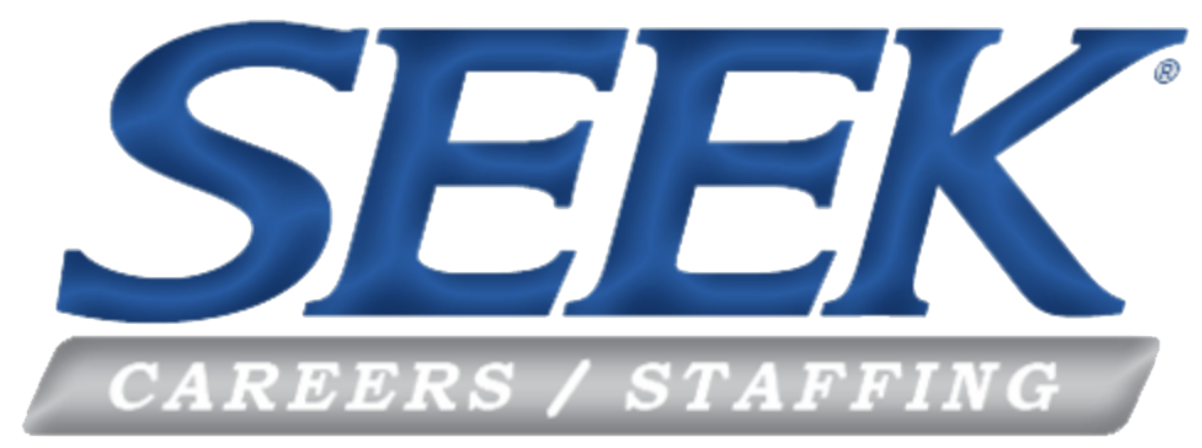Workplace Safety Protects Our Most Valuable Asset – YOU!
As we enter the month of June, it’s essential to recognize that it’s not just any ordinary month, it’s National Safety Month! This annual observance serves as a powerful reminder of the importance of workplace safety, and the role each of us plays in ensuring a secure and productive environment. It presents an excellent opportunity for us to reinforce our commitment to fostering a culture of safety, where everyone can thrive without compromising health or security.
Why is Workplace Safety Crucial?
First and foremost, prioritizing workplace safety protects our most valuable asset—YOU. At SEEK Careers/Staffing, we value your well-being above all else. By reducing accidents and injuries, we can all enjoy a sense of security and peace of mind, both on and off the job.
Workplace safety isn’t just a matter of compliance or ticking boxes on a checklist. It is an investment in our collective well-being, productivity, and success. When safety is prioritized, it leads to numerous benefits for both employees and employers.
National Safety Month encourages us to reflect on our safety practices and evaluate how we can further enhance them. It prompts us to review existing protocols, identify areas for improvement, and actively participate in promoting a safer workplace.
In this blog, we will explore some of the top safety tips to help both employees and organizations cultivate a culture of safety and well-being.
Safety Tips for Success – Employees
Follow Safety Procedures: Familiarize yourself with the safety procedures and protocols specific to your workplace. Adhere to them diligently to minimize risks and prevent accidents.
Use Personal Protective Equipment (PPE): Wear the appropriate PPE, such as helmets, safety glasses, gloves, earplugs, or respirators, as required by your job tasks. Properly maintain and replace damaged or worn-out PPE.
Practice Good Housekeeping: Keep your workspace clean and organized. Remove obstacles, spills, and clutter that can cause slips, trips, or falls. Report any potential hazards to the relevant personnel.
Lift Safely: When lifting heavy objects, use proper lifting techniques. Bend your knees, keep your back straight, and lift with your legs. Seek assistance or use mechanical aids if an object is too heavy to lift alone.
Take Breaks and Rest: Avoid overexertion by taking regular breaks and resting when necessary. Prolonged physical strain can lead to fatigue and increased risk of accidents.
Report Unsafe Conditions: Be proactive in identifying and reporting unsafe conditions or hazards to your supervisor or safety representative. This includes malfunctioning equipment, damaged infrastructure, or any potential risks that may compromise safety.
Maintain Ergonomics: Ensure your workstation is ergonomically designed to prevent strain or injury. Adjust your chair, monitor, and keyboard to promote good posture. Take micro-breaks and stretch regularly to alleviate muscle tension.
Stay Alert and Focused: Pay attention to your surroundings and stay focused on your tasks. Avoid distractions, such as excessive cellphone use, when operating machinery or engaging in hazardous activities.
Practice Safe Electrical Usage: Follow electrical safety guidelines by using properly grounded equipment, avoiding overloading electrical outlets, and reporting any signs of electrical hazards, such as frayed cords or sparking outlets.
Participate in Safety Training: Attend safety training sessions and actively engage in learning about workplace hazards, emergency procedures, and proper safety practices. Stay updated on the latest safety protocols and encourage others to do the same.
For additional tips, check out this article from the CDC (Centers for Disease Control and Prevention)
Safety Tips for Success – Employers
Conduct Regular Safety Training:
Ensure all employees receive comprehensive safety training upon joining the organization and provide regular refresher courses. Educate employees on potential workplace hazards, emergency procedures, proper equipment usage, and safety protocols specific to their roles. Encourage employees to actively participate in safety training sessions and provide feedback to improve safety measures.
Implement Effective Communication Systems:
Establish clear communication channels to disseminate safety-related information efficiently. Use signs, posters, and labels to highlight potential hazards, emergency exit routes, and safety protocols. Encourage open communication between employees and supervisors, enabling the reporting of unsafe conditions or near misses without fear of reprisal.
Regularly Inspect and Maintain Equipment:
Ensure all machinery, tools, and equipment are regularly inspected and maintained to prevent malfunctions or accidents. Develop a preventive maintenance program, conduct routine inspections, and promptly address any identified issues. Provide clear guidelines for equipment operation and restrictions to mitigate risks.
Establish Emergency Response Plans:
Develop and communicate comprehensive emergency response plans that cover various scenarios, including fires, natural disasters, medical emergencies, and security threats. Conduct regular drills and train employees on evacuation routes, assembly points, and first aid procedures. Ensure emergency equipment, such as fire extinguishers and first aid kits, are easily accessible and regularly maintained.
Foster a Safety Culture:
Creating a strong safety culture is essential for long-term workplace safety. Encourage employees to actively participate in safety committees, share suggestions for improvement, and reward safe behavior. Recognize and appreciate employees who consistently prioritize safety and involve them in developing safety policies and initiatives.
Safety Success is a Shared Responsibility
National Safety Month is a call to action—a call for us to unite in our commitment to workplace safety. Remember, safety is a shared responsibility. Together, we can create an environment where everyone feels protected, supported, and empowered to perform at their best.
Thank you for your unwavering dedication to safety! Let us make workplace safety a priority not just for this month, but every day of the year.
Additional Safety Resources:
Wisconsin Department of Workforce Development Safety Guide
Wisconsin Safety Council National Safety Month Resources


